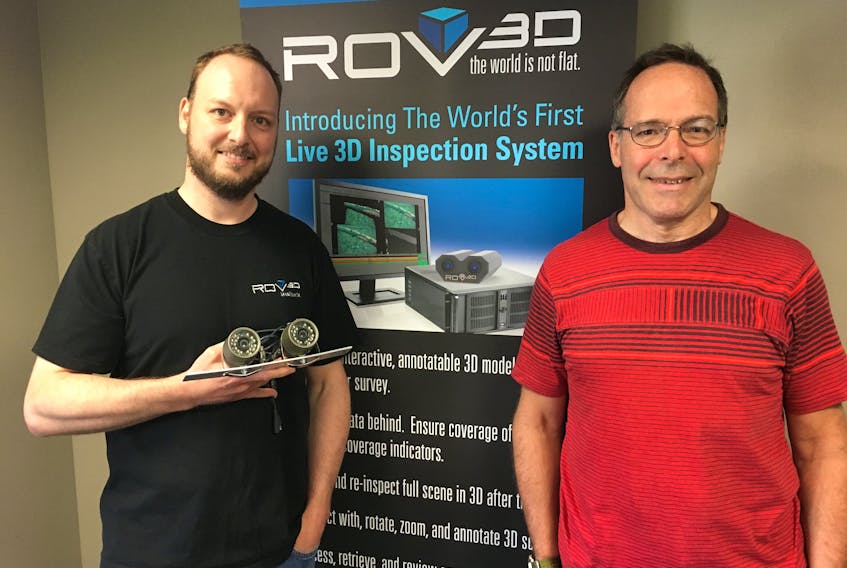Offshore oil and gas companies around the world invest hundreds of millions of dollars in the subsea assets of their operations and they’ll spend millions more inspecting the assets over their lifespan.
Right now, the industry relies primarily on two-dimensional video feeds for its general visual inspection (GVI), but that can prove to be a very time-consuming and frustrating process.
“You can never just go down and be next to an asset, so instead, you're forced to deal with a flat, blurry image from kilometres away and you can only touch with robotic arms,” explains Dr. Sam Bromley, CEO of Whitecap Scientific in St. John’s.
“The entire experience is very subjective and frustrating.”
In response to that challenge, Bromley and co-founder Richard Carron, the firm’s chief science officer, developed the world’s first three-dimensional inspection system called ROV3D, which uses the images captured by a pair of standard subsea cameras to generate interactive three-dimensional reconstructions that allow for a more in-depth and accurate inspection.
There are other products that achieve a similar result — whether it’s laser scanning, 3-D sonar systems (which often suffer from poor spatial resolution) or photogrammetry, which also produces 3-D models — but none of them function in real time.
“What we bring to the table instead is a live technology that reconstructs the video at the same time you record, using the same kind of process you would do for underwater video inspection,” explains Bromley.
“That live feed allows you to guarantee you have the coverage you need and the quality of your results. It's all objectively measureable and is accurate to a centimetre in all three dimensions.
“We really see ourselves as the future of video inspection.”
Another feature of the software is that it allows for the 3-D model to be annotated and “pinned” to indicate areas of interests for further examination.
“It makes it feel like you're interacting with the asset itself more than just recording of the asset. It tries to close that gap for people a little bit.”
What’s more, there are significant cost benefits to Whitecap’s technology.
It doesn’t require any special equipment or a change to the video inspection process, and it requires far less time fast forwarding and rewinding through hours of tape to identify areas of concern.
Since part of Whitecap’s mission is to simplify the process for its clients, there’s no extra crew required and all the necessary training can be completed in about three hours.
The real-time aspect also offers a cost saving in that there’s no need to return to the site over and over again to finalize measurements.
“You get the spatial data set that allows you to do this really good analysis once the campaign is over, but in real-time we're saving them big dollars, too, because they can collect video faster, take measurements faster, and move on to the next,” explains Matt Simms, Whitecaps’ manager of sales and marketing.
“It's saving them money on both ends.”
Since launching the tech in 2015, Whitecap has done well in the busy offshore waters of the North Sea, landing contracts with operators such as Shell and BP, and to oil and gas service providers such as Subsea 7 and Fugro. The company just wrapped up a contract with Suncor on its Terra Nova development.
“We started global and we came back once people locally realized we were already working global,” says Bromley, who attributes their limited work in the province’s offshore thus far to the sector’s youth compared to that in the North Sea.
“The number of assets locally is still manageable with traditional approaches. Statistically, you don't see as many odd cases to bring about a feeling of urgency in adopting new technology to make things more efficient on a large scale because we haven't hit those problems of scale yet.”
While Whitecap’s focus is on building its reputation and earning its stripes in the offshore, there’s always an eye cast to other sectors where it may be of use. Bromley says there’s been interest from the aerial drone industry and from the Unites States Navy, but there’s also possible applications in hydroelectric dams, offshore wind, municipal infrastructure and archeological exploration.
“There's a lot of different verticals that we could play an interesting role in and whether that becomes Whitecap or we partner with somebody and they develop that industry under licence is to be determined,” says Bromley.
“It's one of those techs that you don't yet know how it's going to be used, but it feels like it has a lot of potential in a lot of different areas.”
Twitter: kennoliver79









